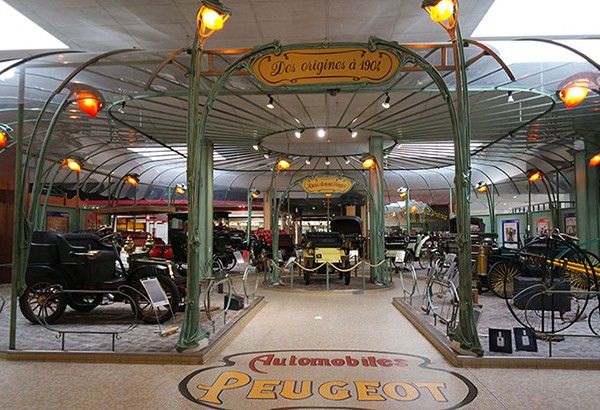Getting to know Peugeot: A historical visit in France

It has been said that we get to truly know and understand people through their family and their history. As I spent time with my in-laws in the United States during the recent Christmas holidays, I realized that there were still more to discover about my husband. I gained a deeper understanding of him as I learned more about his family and his past.
Cars are like people, too, in this sense. I’ve been a fan of Peugeot vehicles for quite some time, but I found a new level of respect and admiration for the brand after I took a historic journey to discover its roots in France.
Only a three-hour ride from Paris is Sochaux—Peugeot’s birthplace and the location of the factory where the new Peugeot 3008 is produced.
One of the main sites in Sochaux (and in all of Eastern France) is “Musee De L’Aventure Peugeot” or the Peugeot Museum. The museum was born as an initiative of the association “L’Aventure Peugeot” in 1982, and was opened to the public in 1988.
L’Aventure Peugeot chronicles the brand’s development from its earliest productions in 1810. Because Peugeot started its business with manufacturing tools, non-car aficionados can enjoy the museum’s wide collection ranging from tools, household items, corsets, bicycles and cars.
The Peugeot Museum is divided in several sections that take its visitors through a chronological journey of Peugeot’s rich history spanning over two centuries. Yes, you read that right. Peugeot has been around for over 200 years! Not many car brands can boast of having that much longevity.
The first section showcases the early activities of Peugeot which include saw blades, corsets, coffee grinders, sewing machines and the first “Grand-Bi” of 1882 (which is a bicycle with a much larger front wheel).
Going to the 1891-1904 section gives a glimpse of the “Pioneers”—the oldest motorcars in the world. The highlight of this section is “Vis-à-vis 1891,” the first gasoline engine automobile manufactured by Peugeot Frères.
Worth visiting also is the section of 1905-1918. This period marks the beginning of industrial production and showcases the famous “Baby Peugeot.” Interestingly, the Baby Peugeot was designed by Ettore Bugatti, founder of the luxury car brand that bears his name. With Bugatti as a newcomer in the automotive industry at that time, the adoption of his design for the Baby Peugeot and its display under the Peugeot brand at the 1912 Paris Motor Show was truly a big break for Ettore Bugatti. The “Baby Peugeot” or “Bébé” was the first Peugeot car to breach 3,000 units of production.
From the early 19th century to the modern era of fifth-generation Peugeot production and concept cars, the Peugeot museum never ceases to delight and amaze its visitors.
The collection includes the “Popemobile” or the Peugeot 504 which Pope John Paul II used in 1988. Movie fans can see the white Peugeot 406 which starred in the 1998 movie “Taxi.”
During my visit, I saw families with young children explore the Peugeot Museum—an indication of Peugeot’s mass appeal.
From the museum to the road, I was able to drive and ride a fleet of Classic Peugeot vehicles that are part of the museum’s collection. Included in the fleet were the Peugeot 601 (1934), Peugeot 402 (1938), Peugeot 203 (1950), Peugeot 403 (1955), Peugeot 404 (1960), Peugeot 304 (between 1974-1979) and the Peugeot 305 (1980). That these vintage cars were still usable and in great shape to drive around Sochaux was a striking testament to the quality and endurance of Peugeot cars.
To cap off my visit in Sochaux, I visited Peugeot’s PSA Sochaux factory. This is the largest automobile manufacturing plant in France and one of the most modern facilities in Europe. The factory is the birthplace of the new Peugeot 3008. Here, I witnessed the meticulous operations and the demanding work culture that go into producing Peugeot cars. Making the visit more memorable was seeing the presence in the factory of the last unit of the older Peugeot 3008 model.
In this day and age, there are so many car brands to choose from. But what sets Peugeot apart is its ability to boast of a rich heritage with a track record of over 200 years of high-quality production and continuous innovation. From the early 19th century to the present day, Peugeot has managed to keep its brand timeless and relevant.
Not all car brands can claim that their lives (or their company) is an open book. L’Aventure Peugeot or the Peugeot Museum serves as an open book sharing Peugeot’s history. But getting to know its past also gives us an insight into how Peugeot continues to shape its future.
Back in Paris I met Peugeot’s CEO Jean Philippe Imparato. His message reinforces the values on which Peugeot’s brand is built on, one of them being the timeless value of respect. Imparato shares the culture they cultivate in Peugeot: “Respect your network, respect your country, respect your customer, respect your people. Then you will see the results. It is not about selling one or two more cars. Just take the time to do the job.”
- Latest






























